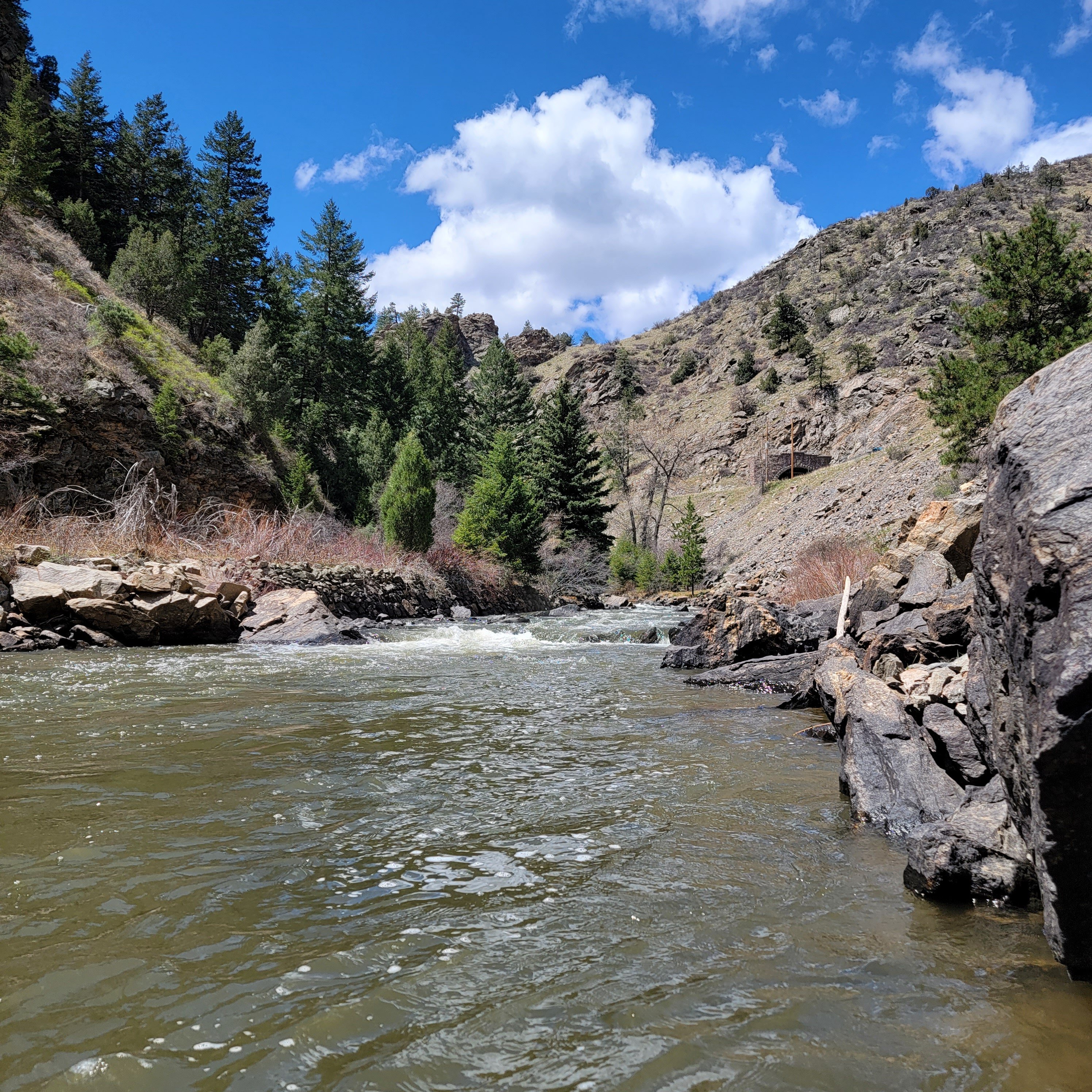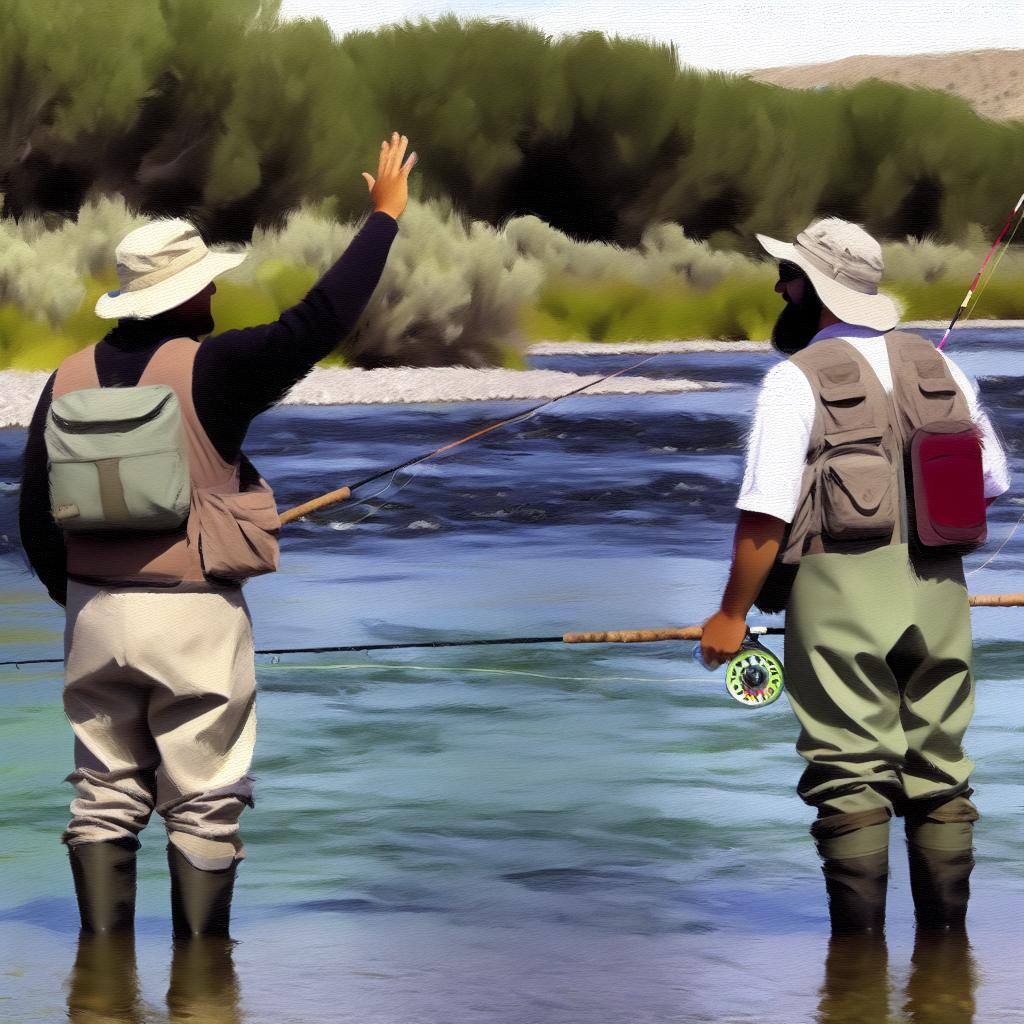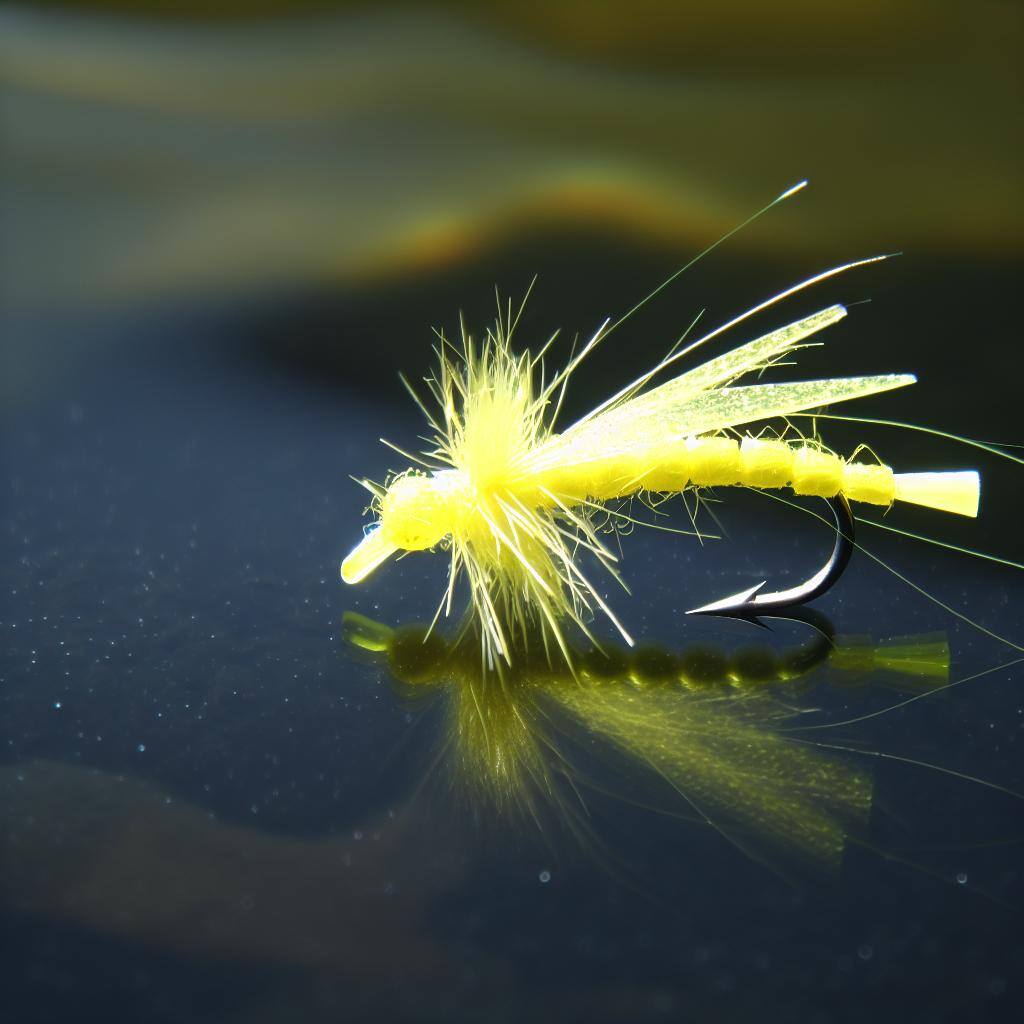Tarryall Creek, located in the South Platte River Basin near Fairplay, Colorado, offers a fantastic fly fishing experience with a mix of rainbow trout, brown trout, and even the occasional brook trout. The creek features diverse habitats, including fast-moving riffles, deep pools, and meandering meadow sections, providing varied opportunities for anglers of all skill levels.
10.29.2024 Fishing Report: Tarryall Creek
%20(4).png?width=800&height=175&name=Guide%20Rating%20(800%20x%20175%20px)%20(4).png)
Current River Conditions
-
Tarryall Creek is currently a great destination for anglers, especially in the cooler fall season. The creek is running low and clear, with a gentle flow that makes it ideal for sight fishing, though the lower water levels require extra stealth to avoid spooking fish. Trout, particularly browns and brook trout, are actively feeding on small aquatic insects as they prepare for winter, and anglers are seeing success with a mix of nymphs and streamers.
Current Flies and Tactics
- Nymphs like small Zebra Midges and Pheasant Tails (#18-22) are effective in the deeper runs and slower pools, where fish are more likely to be holding.
- Streamers such as small Woolly Buggers and Scuds can also be productive, especially in areas with more cover or structure where trout are likely hiding.
- With the cooler fall temperatures, the best fishing times are mid-morning through the afternoon, as trout become more active after warming up from the chilly night.
Summary of Conditions
- Flow Rate: Low, requiring a cautious approach
- Clarity: Clear
- Best Times: Mid-morning to afternoon for peak activity
Tarryall Creek offers a peaceful autumn fishing experience with beautiful scenery and active trout, perfect for anglers looking to enjoy a more remote location this season.
River Flow Chart

source: Colorado Divison of Resources Station Flow Report
For real-time data on river conditions, visit the Colorado Division of Water Resources.
Hatches & Recommended Flies:
Dry Flies
-
Elk Hair Caddis
Sizes: #14-18
When to Use: This pattern is ideal during caddis hatches, which are common in the late spring through early fall. The Elk Hair Caddis is particularly effective in the slower meadow sections and the creek's edges where trout are rising. -
Parachute Adams
Sizes: #16-20
When to Use: A versatile fly that imitates a variety of mayflies. It’s great for targeting rising trout during Blue Wing Olive (BWO) and Pale Morning Dun (PMD) hatches, especially in the clear, slow-moving pools of Tarryall Creek. -
Yellow Stimulator
Sizes: #12-14
When to Use: Effective during stonefly hatches or when fishing faster water where a more visible and buoyant fly is needed. The Yellow Stimulator works well in the upper sections of Tarryall Creek where there are more riffles and faster currents. -
Hopper Patterns (e.g., Dave’s Hopper, Charlie Boy Hopper)
Sizes: #8-10
When to Use: Terrestrial patterns are excellent in the late summer and early fall when grasshoppers are abundant. These flies are particularly effective in the meadow sections where trout feed opportunistically on terrestrials.
Nymphs
-
Pheasant Tail Nymph
Sizes: #14-18
When to Use: A reliable pattern that mimics a variety of aquatic insects. It is effective in both riffles and pools, particularly during mayfly hatches. This nymph is a great choice for fishing under an indicator or as a dropper in a dry-dropper rig. -
Copper John
Sizes: #14-18
When to Use: The Copper John is effective in deeper, faster water where getting the fly down quickly is important. This pattern works well in the faster sections of the creek where trout hold close to the bottom. -
Flashback Pheasant Tail
Sizes: #16-18
When to Use: Effective when fished in clear water conditions, this pattern mimics the nymph stage of mayflies and is great for targeting trout feeding in deeper runs and riffles. -
Two Bit Hooker
Sizes: #16-18
When to Use: This heavily weighted nymph is perfect for getting down quickly in deep runs and pools. It imitates a variety of aquatic insects and is particularly effective in the faster, rocky sections of Tarryall Creek.
Streamers
-
Woolly Bugger
Sizes: #6-10
When to Use: Woolly Buggers are versatile streamers that can imitate baitfish, leeches, or larger aquatic insects. They are effective in deeper pools and around structure, particularly in low-light conditions or when the water is slightly off-color. -
Zonkers
Sizes: #6-8
When to Use: Zonkers mimic small baitfish and are effective in deeper, slower-moving sections of the creek where larger trout may be lurking. Fish these streamers near undercut banks and around submerged logs or boulders.
Fishing Tactics
Dry Fly and Dry-Dropper Fishing
Dry fly fishing and dry-dropper rigs are particularly effective on Tarryall Creek, especially when targeting trout in the meadow and slower sections where fish are more likely to rise to the surface.
-
Dry-Dropper Rigs: This setup is ideal for Tarryall Creek, combining a high-floating dry fly (such as a Chubby Chernobyl or Yellow Stimulator) with a nymph or emerger pattern (like a Pheasant Tail or RS2) suspended below. This rig allows you to target both surface-feeding and subsurface trout, making it versatile for various water types. The dry fly serves as an indicator and can attract trout on its own, while the nymph below covers fish feeding beneath the surface. This setup is particularly effective in the meadow sections and slower pools of the creek
-
Presentation and Timing: Focus on presenting your dry flies with a delicate, drag-free drift to imitate natural insect behavior. Early mornings and late afternoons are the best times for dry fly action, especially during hatch periods or when terrestrials are most active. Target areas with slow-moving water, seams, and the edges of deeper pools where trout are more likely to rise.
Nymphing Techniques
Nymphing is a highly productive technique on Tarryall Creek, especially in the faster-moving sections and deeper pools. Given the creek's diverse habitats, getting your nymphs to the right depth and presenting them naturally is key.
-
-
Two-Fly Nymph Rig: Use a two-fly nymph rig with a heavier attractor fly (like a Bead Head Prince Nymph or Copper John) as the point fly, followed by a smaller, more imitative nymph (such as a Zebra Midge, Flashback Pheasant Tail, or JuJu Baetis) as a dropper. This setup allows you to cover multiple depths and imitate different food sources, which is ideal for Tarryall Creek’s varying conditions Tarryall Land and Cattle Ranch
-
-
-
Adjusting Depth and Weight: Pay attention to the creek's flow and depth, adjusting your weight and indicator position to ensure your flies are drifting naturally just above the bottom. In faster sections, use enough weight to get your flies down quickly and keep them in the strike zone. Strike indicators help detect subtle bites in the deeper runs and pools.
-
High-Sticking Technique: In tighter sections with faster currents, high-sticking nymphing (keeping a tight line with minimal slack) can be effective for targeting trout in deeper runs and pockets. This technique allows for better control of the nymphs and improves sensitivity to strikes, especially in areas where fish are holding near the bottom.
-
-
Streamer Fishing
Streamer fishing can be very effective on Tarryall Creek, particularly when targeting larger, more aggressive trout or when the water is slightly off-color due to recent rain.
-
Swinging and Stripping Streamers: Use streamers like Woolly Buggers, Zonkers, or Mini Sculpins to imitate small baitfish, leeches, or crayfish. Cast these patterns into deeper pools, along the edges of faster currents, or near undercut banks where larger trout may be hiding. Experiment with different retrieve speeds—short, quick strips can mimic a fleeing baitfish, while slower, steady pulls can imitate a wounded prey item
-
Low-Light Conditions: Streamer fishing is often most productive during low-light conditions, such as early morning or late evening. It can also be effective during overcast days or when the water is slightly off-color, making trout less cautious and more likely to chase larger prey.
-
Access Points:
Tarryall Reservoir Outlet
- Location: Just below Tarryall Reservoir, accessible from County Road 77 (Tarryall Road)
- Description: This is one of the most popular access points for anglers. The water here is tailwater, meaning it's fed from the bottom of Tarryall Reservoir, which keeps it cool and productive throughout the year. The section below the reservoir outlet is characterized by riffles and deep pools, which are excellent for both nymphing and dry fly fishing.
- Access Tips: Park near the Tarryall Reservoir parking area. Make sure to check local fishing regulations, as some sections may have special rules or restrictions.
Tarryall Road (County Road 77) Pull-Offs
- Location: Along County Road 77 between Tarryall Reservoir and Jefferson, CO
- Description: Multiple pull-offs and parking spots along County Road 77 provide access to various sections of Tarryall Creek. This stretch includes a mix of riffles, runs, and deep pools, ideal for dry fly fishing and nymphing. The creek meanders through willows and open meadows, providing a variety of fishing environments.
- Access Tips: Look for safe pull-offs and parking areas along County Road 77. Be mindful of private property signs and make sure to respect the boundaries. This road follows the creek closely, so it offers many convenient access points for a day of fishing.
Tarryall State Wildlife Area
- Location: South of Tarryall Reservoir along County Road 77
- Description: This state wildlife area offers public access to Tarryall Creek. It features several miles of fishable water with diverse habitats, including faster riffles and slow-moving bends. The wildlife area is well-maintained and offers a more secluded fishing experience compared to areas closer to the reservoir.
- Access Tips: There is designated parking at the wildlife area entrance. From here, trails lead directly to the creek. It’s a great spot for anglers looking for a quieter section to fish. Remember to carry a valid Colorado fishing license and adhere to wildlife area rules.
Tarryall Land and Cattle Ranch (Private Access)
- Location: Near Jefferson, CO
- Description: This private ranch offers exclusive fly fishing access to a prime section of Tarryall Creek. The ranch provides a unique opportunity to fish in a managed environment with less fishing pressure. The creek here flows through a mix of canyon sections, wetlands, and meadow areas, offering a variety of fishing conditions and habitats.
- Access Tips: Access is by reservation only, and anglers must book their trip in advance through the Tarryall Land and Cattle Ranch website. This private section provides a more controlled and guided experience, ideal for those looking for a premium fishing outing
Jefferson Lake Road (Forest Service Road 129)
- Location: Off County Road 77 near the town of Jefferson, CO
- Description: This access point is near the upper reaches of Tarryall Creek, closer to its headwaters. The water is narrower and more technical, with a mix of small pools and pocket water ideal for dry fly fishing. The less frequented area offers a more remote and peaceful fishing experience.
- Access Tips: Drive along Jefferson Lake Road (FSR 129) and look for pull-offs where you can park and walk down to the creek. Be prepared for rugged terrain and be mindful of forest service regulations regarding vehicle access and parking.
.png?width=938&height=313&name=Rise%20Beyond%20Logo%2010.29.24%20300x100px%20(3).png)
.png)



